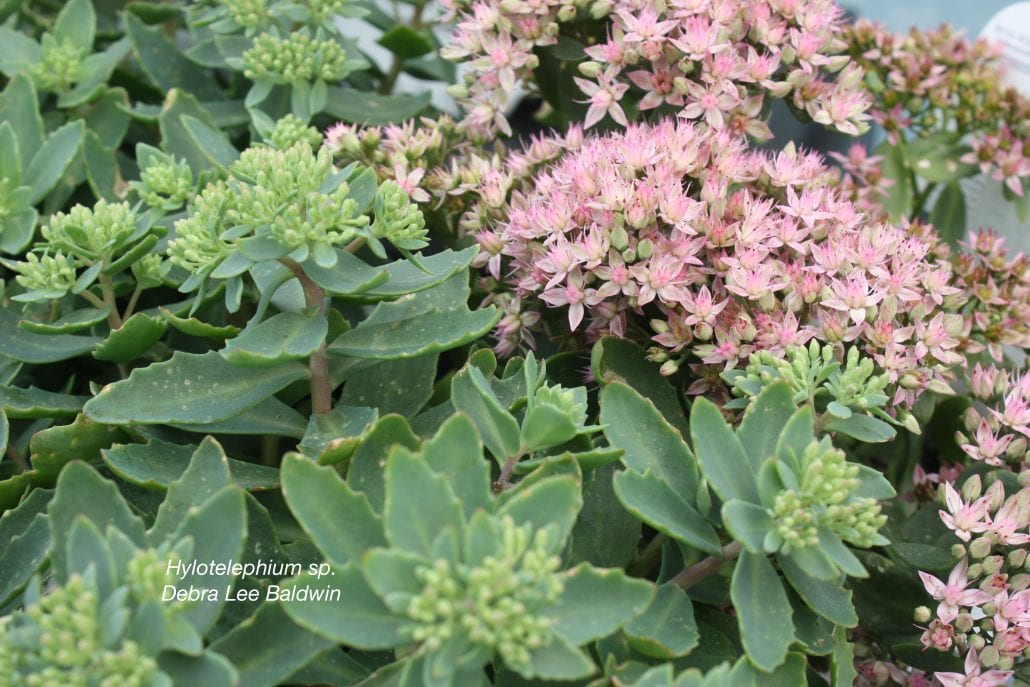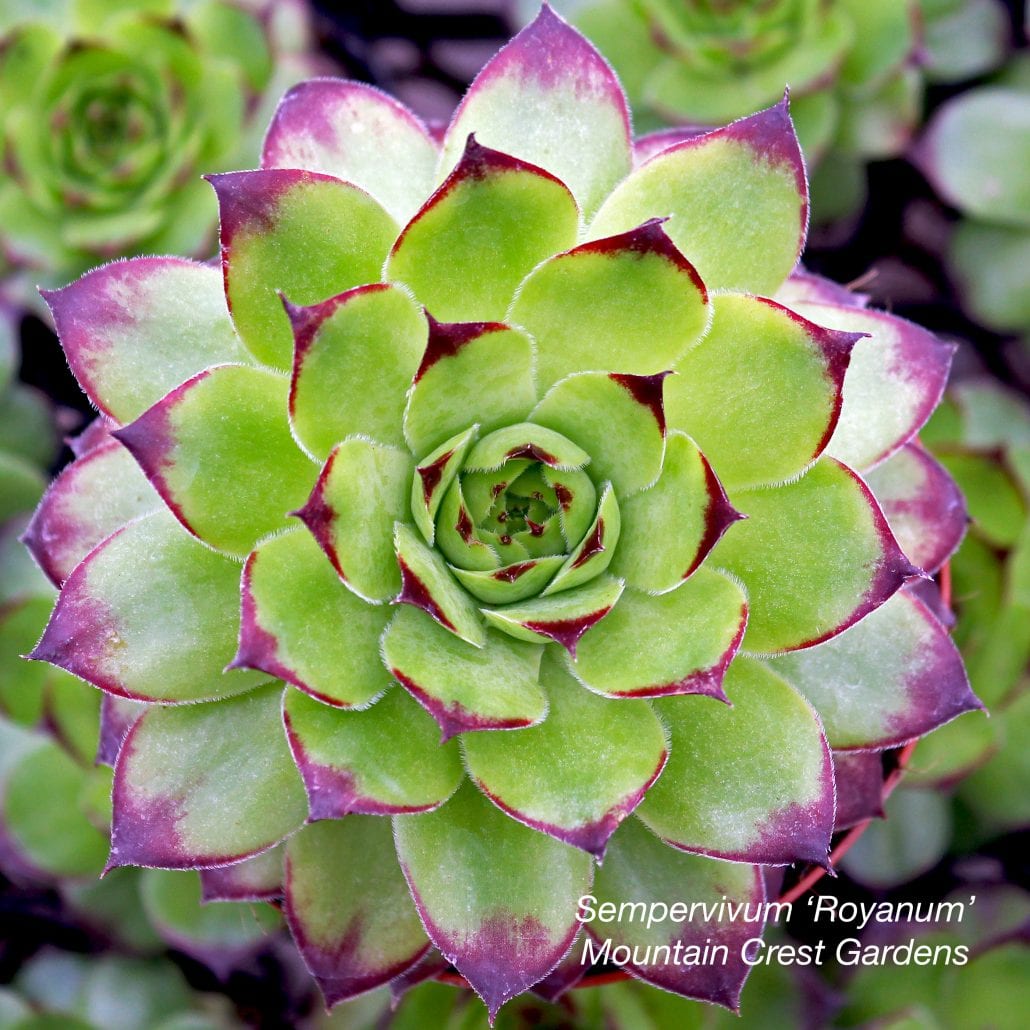
Showy Succulents for Snowy Climates (Debra’s WSJ Article)
Showy Succulents for Snowy Climates This is the unabridged original of the article I wrote for the Wall Street Journal.

Snow heightens the color of hens-and-chicks (Sempervivum globiferum 'Connie'). Photo: Mountain Crest Gardens
Is it a given that Northerners can't grow succulents? Not at all. Granted, most of these moisture-storing, arid-climate plants prefer warm, sunny habitats. Yet in response to demand, major growers are cultivating tough, showy varieties that sail through subzero winters. The two main kinds are stonecrops and hens-and-chicks, but there are others that may surprise and delight you.
Stonecrops

Golden barrel cactus is cold hardy only to 14 degrees F, but dainty-looking 'Angelina' stonecrop will go well below zero.
Tiny-leaved ground covers like 'Angelina', commonly known as stonecrops, spread “even in Zone 3,” notes Panayoti Kelaidis, senior curator of the Denver Botanic Gardens. "They'll root from little pieces. There are hundreds of different kinds, and they’re the backbone of green roofs.”

Kelaidis says that clump-forming succulents once classified as Sedum (now in the genus Hylotelephium) are "probably the most important succulents for perennial gardens" because of their size and year-round beauty. Like sedums, these have star-shaped flowers in clusters, but unlike true sedums, hylotelephiums form tap roots and have rosy flowers rather than yellow. Although the top growth of hylotelephiums dies and turns brown in winter, “don’t cut them back until spring,” Kelaidis advises. “The dry flower stalks look great covered with snow.”

Plant breeder Brent Horvath of Intrinsic Perennial Gardens in Hebron, IL is perhaps best known for upright sedums with serrated chartreuse leaves and flowers that blanket the plants with clouds of pink. Horvath authored "The Plant Lover’s Guide to Sedums" (Timber Press, 2014).
In his book, Horvath says of the best-known perennial sedum, Autumn Joy (Hylotelephium ‘Herbstfreude’), “The flower heads of soft raspberry pink deepen to garnet as fall approaches. What’s more, in all but the harshest climates, this tenacious plant continues to delight through the winter months as its flower heads turn copper, then bronze.”
Monrovia nursery notes, "This sturdy perennial is as tough as they come. Clumping foliage displays large, plate-like flower clusters... Succulent foliage will die back to the ground in cold winter regions, but will re-emerge in early spring."
Hens-and-chicks
Succulent hens-and-chicks, so called because offsets ring the mother rosette, are in the genus Sempervivum, meaning “ever-living.” "Many of our semps and hardy sedum spent over a month buried in 18 inches of snow last year, resulting in tremendously vivid red, pink, purple, and even some orange tones later in the spring," says Matts Jopson, VP of Mountain Crest Gardens near Mt. Shasta in Northern CA. "They also survived a record -15 F night without issue." Certain semps will look different throughout the year, depending on variety and climate, and warm colors caused by cold may settle into shades of green by late summer.
One of a handful of nurseries specializing in hardy succulents, Mountain Crest Gardens' "rapid growth has continued through 2017, and we’ve been expanding our selections like never before," Jopson says. "We should have at least 200 different hardy varieties for sale this spring, at least 50 of which we consider to be rare collectibles."
Nearly all of the succulents found in the nursery's Hardy Succulent category can be grown outdoors year-round in zone 5 (-20F) areas such as New York, Boston, and Chicago. "We created that category and our own definition of “hardy” exactly for this purpose," Jopson says, "to let the large northern population of the U.S. (and thus most of the country’s population) know that they can grow a wide selection of beautiful succulents outside through the winter. Even people in colder Minneapolis should be fine keeping many of the Sempervivum heuffelii and hardy Sedum outdoors."
Sempervivum heuffelii are "truly special plants," Jopson says. They have...
- More consistent year-round color than regular Hens and Chicks
- “Glowing” edges
- Foliage is probably the most durable of any hardy succulent
- Many are more tolerant of indoor light than semps.

Several Sempervivum cultivars by Kevin Vaughn
Mountain Crest Gardens works with a hybridizer and creator of "many beloved semp cultivars," Jopson says: Kevin Vaughn of Salem, OR. Vaughn holds a hybridizing clinic each year in April "organized by the avid semp community on the garden.org forums." Jopson adds that the breeder's current goal is to hybridize "a 'football sized' semp with the dark color tones of an Aeonium ‘Black Rose’."
Vaughn's book is a must-have for semp enthusiasts: Sempervivum: A Gardener's Perspective of the Not-So-Humble Hens-and-Chicks.
Among professional breeders of cold-hardy succulents mentioned by Jopson and Kelaidis is Chris Hansen of Michigan-based Garden Solutions (chris@sunsparklersedums.com). Hansen says of one of his cultivars, Sempervivum 'Gold Nugget', "It's a once-in-a-lifetime plant, the world's first bright yellow semp with red tips." In northerly climates, 'Gold Nugget' turns shades of lime green and hot pink in summer, gold and red in spring and fall, and warm red in winter.

Chris Hansen shows Sempervivum 'Gold Nugget', part of his registered Chick Charms line of hens-and-chicks.
See more of Hansen’s patented plants, including his SunSparker Sedums, on my 50 Cold Hardy Succulents for Northern Climates page. His online mail-order plant business (with Mary Walters) is www.GreatGardenPlants.com.
Sempervivums are monocarpic, meaning that after a rosette blooms, it dies. But this seldom compromises a colony's appearance. Chicks carry on, filling gaps with their own offsets in spring.
Ice plants

Delosperma 'Fire Spinner' is a Kelaidis introduction
Naturally Kelaidis mentions ice plants, of which he says tongue-in-cheek, “I invented 35 years ago.” He trekked through Siberia, Mongolia, and similarly remote, high-elevation regions seeking mat-forming succulents with shimmering, daisylike blooms. Kelaidis went on to introduce many—including his own hybrids---to gardens in the Rockies and beyond.

Asked to name an ice plant that's especially floriferous, Kelaidis praises purple Delosperma cooperi: "It blooms all summer.” The plant, which Kelaidis has helped popularize over his 35-year career, is readily available nationwide. He says proudly, "Hundreds of millions sold."
How to Grow the Hardies
There’s more to growing hardy succulents than plunking them in the ground. They need to be acclimated to the cold. Jopson advises: "It’s never a good idea to leave them outside in a hard freeze immediately after delivery. Established root systems are required for most hardy succulents to survive the coldest winter temps, and it is recommend to plant in the ground, beds, or large containers for additional insulation for the roots. Snow is actually welcomed by hardy varieties as it can insulate them from frigid air temperatures."
“Wetness is the enemy,” cautions Kelaidis. “Plant them in walls, rock gardens and shallow containers.” Give in-ground plants maximum sun exposure and “a microclimate similar to a Russian steppe:” a south-facing slope amended with coarse, gritty soil.
RELATED INFO
Books
- Designing with Succulents (2nd ed.) See the section on Cold-Climate Succulent Gardens.
- All my books show design ideas and give care and cultivation for Sedum and Sempervivum.
- The Plant Lover’s Guide to Sedums, by Brent Horvath (Timber Press)
- Cacti & Succulents for Cold Climates, by Leo Chance (Timber Press)
- Hardy Succulents: Tough Plants for Every Climate, by Gwen Kelaidis, Photos by Saxon Holt (Storey Publishing)
- Sempervivum: A Gardener's Perspective of the Not-So-Humble Hens-and-Chicks by Kevin Vaughn
How to Grow Tender Succulents in Cold, Northerly Climates
With the exception of sempervivums, jovibarbas, many sedums and yuccas, and certain cacti and ice plants, the majority of succulents are frost-tender. Although they can tolerate temps down to freezing and in excess of 90 (if shaded), between 40 and 80 degrees is ideal. But you can grow any succulent, anywhere, if you understand its needs.
Cold Hardy Succulents: Details, Photos and Varieties
Cold-Hardy Succulents: Details, Photos & Varieties Looking for succulents that go below freezing? You’re in the right place! About cold-hardy succulents The common cold-hardy succulents shown here can handle northern winters, snow, rainstorms (if given excellent drainage) and summer dry spells. Sedum (stonecrop) Trailing varieties are lovely as ground covers and in rock gardens, terraces and hanging…
50 Cold-Hardy Succulents for Northern Climates
The popular and readily available varieties shown here can handle northern winters, snow, rainstorms (if given excellent drainage) and summer dry spells. There are two main genera: Sedum and Sempervivum. Lesser known are Rosularia, Delosperma, and Orostachys. Notably, certain species of Agave and cacti don’t freeze in all but the coldest climates.








I had my succulents ( mostly Hens and chicks) in a little dome shaped greenhouse during the winter. Even though I had a grow light and heat lamp on them for about 10 hours a day, and watered them once in December and again in February, they either turned to mush, or had stout a half inch of dried out dead petals on the lower half.
There inside now, but what can I do now to revive them? I’m near Pittsburgh Pa.